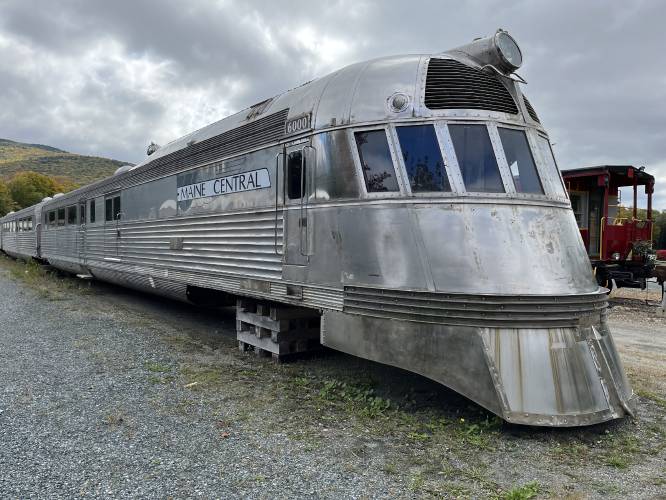Flying Yankee Association puts in a bid to save the famous NH train

The Flying Yankee ended service in 1955. N.H. Preservation Alliance
| Published: 02-18-2024 7:00 AM |
Fans of the Flying Yankee, an eye-catching train that called Concord home for two decades before ending passenger service in 1955, have put in a bid to own the train and help decide its future.
“Our goal is to restore as much as possible, try to use the original parts as we can … and to run the train, not to put it in a museum,” said Jacob Eidsmoe, marketing director for the Flying Yankee Association. “We’d be keeping it in New Hampshire, that’s a given.”
The association has submitted a bid to the state, which announced last month that it wanted to sell the train and cars for a nominal amount and was accepting proposals for the “purchase, relocation and encouraged preservation.” The Department of Transportation is reviewing all proposals that were submitted by the Jan. 4 deadline and will be posting details and requesting permission from the governor and Executive Council “in a few weeks,” said DOT spokesman Richard Arcand.
The Flying Yankee Association is a non-profit “reboot,” in Eidsmoe’s words, of the Flying Yankee Restoration Group that tried for years to resurrect the train in some form, including an idea to make it the centerpiece of a transportation museum along Concord’s railroad tracks. The association has been developing a network of supporters in preparation for its efforts, although it’s delaying fundraising until it knows whether it actually owns the train.
The Flying Yankee was one of a handful of trains built with the stainless steel “streamliner” design, which shared sets of wheels among the locomotive and the first two passenger cars. This made the train lighter but also made it harder to reconfigure for different jobs and hard to fit into some rail yards, which is why the design was eventually abandoned.
From 1935 to 1955 the Flying Yankee, under a variety of names, racked up 3.5 million miles carrying passengers and freight throughout the Northeast for the Boston and Maine Railroad. It was maintained at B&M’s South Concord Shops, which employed thousands of people between South Main and Water streets.
After it was retired, the Flying Yankee spent years at the Edaville Railroad museum in Carver, Mass., before ending up at the Plymouth and Lincoln Railroad, better known as the Hobo Railroad. The train, which can no longer travel under its own power, has been outdoors in Lincoln since. The Hobo Railroad was bought last summer by Patriot Rail, a national operator of short line and regional freight railroads and rail services companies.
If the association gets the train, Eidsmoe said, the first step will be figuring out what shape it is in, including the large collection of parts that are stored in crates.
Article continues after...
Yesterday's Most Read Articles
“We’ll try to use the original parts, as we can. Some we can’t – it will need new windows, new electrical to meet requirements and codes – but many we can,” he said. For example “the chairs, we want to keep them as close to 1935 look and feel as possible.”







 ‘A little piece of everything I like’: New Pittsfield barbershop brings more than a haircut to downtown
‘A little piece of everything I like’: New Pittsfield barbershop brings more than a haircut to downtown NH judge decides to pause Trump’s birthright citizenship order
NH judge decides to pause Trump’s birthright citizenship order Canterbury honors ‘real heroes’ with updated Military Veterans’ Project
Canterbury honors ‘real heroes’ with updated Military Veterans’ Project Look, up in the sky! It’s… an Airstream trailer?
Look, up in the sky! It’s… an Airstream trailer?
